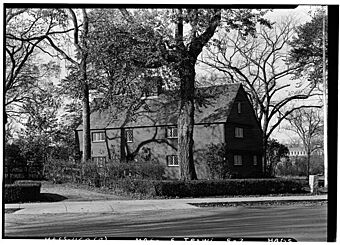John Whipple House facts for kids
|
John Whipple House
|
|
|
U.S. Historic district
Contributing property |
|

John Whipple House
Ipswich, Massachusetts |
|
| Location | 1 South Green, Ipswich, Massachusetts |
|---|---|
| Built | 1677 |
| Architect | Whipple, John |
| Architectural style | Salt Box |
| Part of | South Green Historic District (ID80000471) |
| NRHP reference No. | 66000791 |
Quick facts for kids Significant dates |
|
| Added to NRHP | October 15, 1966 |
| Designated NHL | October 9, 1960 |
| Designated CP | September 17, 1980 |
The John Whipple House is a super old and special house located at 1 South Green in Ipswich, Massachusetts. It was built way back in the 1600s! Imagine living in a house that's hundreds of years old. Today, it's a museum where you can learn about history. It became a National Historic Landmark in 1960, which means it's a really important place in American history.
Contents
The House's Story
Building a Home in the 1600s
The John Whipple House was started in 1677 by Captain John Whipple. It was built at the corner of Saltonstall and Market Streets. At first, it was a "half-house" made of wood, with a chimney on one side.
In 1690, Captain John's son, Major John Whipple, made the house bigger. He added another "half-house" next to the front door. This made the house much larger.
Growing and Changing Over Time
By 1705, more parts were added to the house. These were like small, one-story rooms called "lean-tos" on the west side. They included a kitchen, a pantry for food, and sleeping areas. These extra rooms were for the people who worked in the house.
Around 1710, the roof on the west side was raised. This created four more rooms with sloped ceilings. The house then had 14 rooms in total, not counting the attic! It was a very big house for its time. It even had high ceilings in most rooms. Because of its size and great location near the river, people called it "The Mansion."
A New Look in the 1700s
In the 1720s, a daughter who inherited the house decided to update it. She changed the outside and some inside parts to match a new style called Georgian. This meant removing some pointy roof parts called gables. She also replaced the old windows with new ones that slid up and down. The main wooden door was changed to a paneled door with a window above it.
Inside, the rooms got smooth plastered ceilings and walls. The wooden beams that were once visible were now hidden. The house stayed this way for a long time.
Saving a Piece of History
By 1898, the house was not in good shape. It had been used as a home for mill workers and then as a shared living space. The Ipswich Historical Society bought it to save it. They worked to make it look like it did in the 1600s again. They put back windows and doors that looked like the originals.
In 1899, the house opened as a museum for everyone to visit. In 1927, the house was moved to its current spot. It now sits on 10 acres of land with woods, fields, and gardens. It faces the same direction as it did originally.
Restoration and Recognition
In the 1950s, termites caused a lot of damage to the house. It had to close for a big repair project. During this work, they found proof that the house once had two gables on the front. So, they added those back! New windows with old-style glass were put in.
The house reopened to the public. In 1960, it was named a National Historic Landmark. This was one of the first times a building received this special honor. It was also added to the National Register of Historic Places in 1966. In 2002, scientists used a method called dendrochronology (tree-ring dating) to confirm the house was built in 1677.
Today, the house still has its original wood frame made of oak, tamarack, pine, and chestnut. Some of the old windows from the 1690s are still there in the lean-to rooms. The Ipswich Historical Society is now called the Ipswich Museum. You can take tours of the house from late May to late October, Thursday through Sunday.
Gallery
More to Explore






